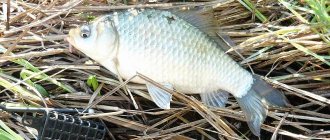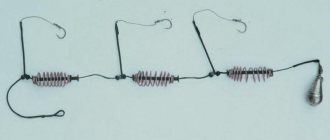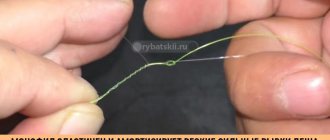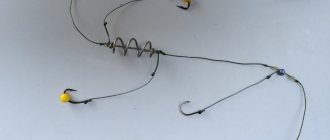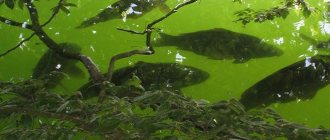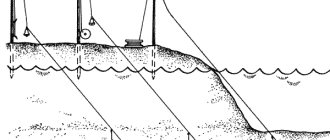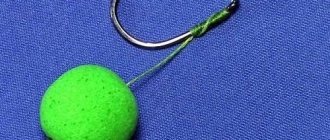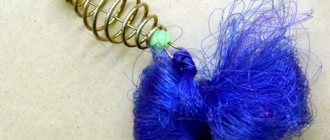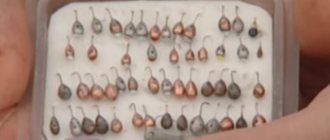Fishing tackle cork - description
This device is highly appreciated by consumers, because gives a good catch result. Fishermen call it differently, but the meaning remains the same. This is a regular plastic stopper with attached hooks and a lead weight at the bottom.
Structure and principle of operation
Components of the gear:
- Lid;
- Fishing line;
- Leash;
- Stopper;
- Sinker;
- Hooks.
The essence of fishing is that the bait is tamped inside. Feeling the aroma, the carcass approaches the delicacy, tastes it, and sucks it out of the cork. At the same time, camouflaged hooks enter the mouth, triggering a bite signal.
Let's celebrate! Often the fish hooks itself, trying to swim away from the feeder. But the heavy cork and hooked hooks do not allow this to be done. A satisfied angler can easily pull out the prey and start making a new cast.
Advantages of gear
- Elementary in use;
- Self-production;
- Possibility of fishing at depth and long distances from the shore;
- Good bite;
- Small amount of complementary foods;
- The tackle does not catch;
- Budgeting;
- Self-hooking of fish.
“Cork” - a cunning homemade bottom tackle
Homemade because you will find it in stores - just do it yourself. This is even better - since you control the entire process from start to finish.
Making the bottom tackle “Cork”
- Take a cork from an ordinary plastic bottle with a volume of 5 liters. Round lead weights are attached to it from below using self-tapping screws.
- The lowest sinker - we make notches so that the cork clings to the bottom and does not get carried away by the current.
- We prepare the hooks - we knit leashes with a hook on both sides. We need 2 of these leashes. Choose hooks with a long shank.
- We drill 2 holes in the walls of the lid opposite each other. One hole is used for the main line or the main leash, which is then attached to the main line through a swivel with a carabiner.
And the other hole is just for leashes with hooks.
- We insert and fasten our tackle through the winding ring.
- Next, we drill an additional 4 holes - cross to cross. And we install wire in these holes.
Essentially, it turns out to be a feeder and this wire cross will prevent the bait dough from falling out.
- We thread a foam ball onto each hook.
- Now we place the hooks with the forend down in the dough.
That’s it, our cunning bottom tackle “Cork” is ready.
If something is not clear, watch the video (below).
Cloudflare Ray ID: 63aa1ae94e494d8c • Your IP: 195.64.208.251 • Performance & security by Cloudflare
Ready-made cork tackle
Ready-made cork tackle
That's it, it's time to go for crucian carp
The fish responds well to such tackle both in spring and summer, because it actively feeds. Therefore, catching crucian carp with a cork in the summer and spring is a one hundred percent guarantee that the fisherman will come home with a good catch.
Fishing for crucian carp in spring with a cork is even more active than in summer, because the good-smelling bait attracts many hungry inhabitants of reservoirs. So, don’t be surprised when at the other end of the fishing rod you see not a crucian carp, but another fish.
Advantages and disadvantages of cork tackle for crucian carp
What’s good about this tackle is that it can be cast quite far, which is especially appreciated in the summer when the fish are hiding in the depths. You don't even need a boat. You can also use cork in the coastal zone, but you should be more careful about possible snags, but this is already a disadvantage. If you want to see how catching crucian carp with a cork happens, watch the video, and then go for real fishing.
In reality, this process is much more interesting!
The basis of the gear is an ordinary plastic (less often metal) bottle cap (for yogurt, milk, water, and so on). In this case, it plays the role of an open bottom feeder. When creating a rig, a flat sinker is used, attached to the bottom of the feeder. Its main purpose is to hold the tackle at one point and prevent the feeder from turning over.
Choosing gear for cork fishing
Fishing from a reservoir with a cork has some peculiarities when choosing gear.
Rod:
- length minimum 2.5 m.
Coil:
- The optimal spool size for this type of fishing is 3000.
Line:
- made of polymer material;
- braided cord in a sheath.
Lead sinker:
By form:
- flat;
- disc-shaped;
- drop-shaped;
- olive
By color:
- The color should blend in with the water or bottom color.
By weight:
- from 30 to 60 grams.
Leashes:
- braided fishing line with a diameter of 0.2 mm;
- length – 5-10 cm.
Hooks:
- high quality;
- the optimal size is No. 6 to No. 21.
Cork:
- height is equal to half the diameter.
Equipment equipment
For the feeder to work well, you need to choose the right equipment. There are no special requirements regarding the fishing rod. Feeders and spinning rods of medium-fast and fast action are more often used. The rod test will depend entirely on the weight of the feeder, which will be quite large . In this regard, medium and medium-heavy forms are taken. Take the most common reel - a spinning reel of the medium-light and middle class for 2000-3000.
Important! If you don’t want to mess around and build a “pacifier” yourself, you can buy ready-made gear. Today they are presented in sufficient quantities in fishing stores and are quite inexpensive.
Lid
The cork is selected according to the ratio of height and diameter. Ideally, the proportion should be 1:2. Lids from cans of yoghurt, juice or drinks are great for such purposes.
Of course, you can use not only the plastic version, but also the metal one. It is easier to load it, for example, with hot lead, but such tackle will quickly fray the fishing line, which is not convenient during operation.
Sinker
Sheet lead is used as a sinker. If it is not available, use any other metal. The only difference is that the first option is soft enough to flatten into the shape of the bottom of the lid. Other metal will have to be melted.
Learn how to catch crucian carp in windy weather.
fishing line
Line parameters are selected depending on fishing conditions. If it is a large body of clean water, not clogged, without a lot of algae, then a thread with a diameter of 0.2 mm is suitable. In the case when hunting is carried out on overgrown ponds, it would be more advisable to take a coarser fishing line. The optimal size is 0.35 mm .
Leashes
It is better to make a leash from monofilament fishing line. You can use a nylon cord, but it is less durable. The diameter of the leader should be similar to the parameters of the main fishing line. But it is permissible to take a slightly smaller size, about 0.1–0.3 mm. The length of the leash should be 10–15 cm.
Hooks
Hooks No. 5 or No. 8 are used as hooks. Ideally, from 3 to 5 pieces should be attached to one plug; less often they put 7 , but this is quite a lot and increases the risk that the fish will notice the bait and swim away. Considering that the tackle is designed for self-hooking, the hooks should be sharpened before each fishing trip. The forend should be short, but well curved upward.
We advise you to learn how to catch crucian carp in June using a float rod.
Silicone stopper
This part of the equipment looks like a tube 3–5 mm long. The line is passed through it twice. The disadvantage of a silicone stopper is that it does not slide well along the fishing rod guides and greatly roughens the equipment. Taking this into account, it is used in parallel with the “pacifier” quite rarely, only when using sliding equipment. If blind installation is carried out, then the stopper is not needed at all.
Bait and lures for fishing with cork tackle
The success of all fishing depends on the correct choice of complementary foods. You can buy the finished mixture at the store or prepare it yourself.
The most effective and efficient bait options:
Corn
- chop 1 can of canned corn;
- pour the remaining juice over the mixture;
- add 100 gr. roasted and crushed sunflower seeds;
- 1 tbsp. a spoonful of honey, vegetable and flaxseed oils;
- Before starting fishing, add breadcrumbs to obtain a thicker and more elastic slurry.
Pea
- boil 3 cups of water;
- add 1 cup of peas and let it brew;
- after half an hour, add half a glass of corn and cook this mixture for 40 minutes, stirring constantly;
- 2 minutes before the end of cooking, add 1 tsp. honey, a tablespoon of sunflower oil and 3 tablespoons of sugar.
Potato and bread
- boil the potatoes;
- grind in a convenient way;
- chop the flour;
- mix these two ingredients;
- add black bread, vegetable and anise oil.
Manna
- prepare semolina porridge in water, in a 1:1 ratio;
- Remove the finished homogeneous mixture from heat, cover with a lid and leave for 20 minutes;
- After the time has passed, grease your hands with vegetable oil and manually mix the contents of the pan.
To maximize the attraction of fish, you can add various natural aromatic additives, bite activators, and attractants to complementary foods:
- Hemp.
- Anise.
- Plum.
- Strawberry.
- Sunflower oil.
- Honey.
- Garlic.
Let's celebrate! The consistency of the mixture should resemble plasticine or thick dough, be viscous and stretchy. Water that is too liquid will quickly wash away, exposing the hooks. The thick filling will be difficult to suck out of the feeder, and the fish will lose all interest in it. You can bring the bait to the required density with flour or semolina.
Technique for catching crucian carp using a “nipple”. Equipping and charging the feeder
The good thing about the “nipple” tackle is that it doesn’t require any special investments. It consists of six elements that have their own parameters.
- You can use any fishing rod: a spinning rod or a telescopic fishing rod with a long whip.
- Reel - both inertial and non-inertial are suitable for catching crucian carp.
- The main fishing line is better to take a braided one, as it has increased sensitivity. It will take about 50 meters.
- Leashes - from the same braided fishing line, pieces of approximately 5-6 centimeters in length are cut.
- Hooks - for catching crucian carp on the nipple, hooks No. 6 and No. 8 are used.
- Alarm - You can use a bell, but this is not necessary.
You can bait the hooks with maggots, worms and bloodworms. Fishermen who have extensive experience in this kind of fishing do not use live bait. Foam balls are used as bait. You can buy them at a fishing store: multi-colored and flavored. But most often ordinary white ones are used.
If all the equipment is ready for fishing, you can start. The main thing is to know how to properly catch crucian carp on a nipple!
- To begin, choose a location. This could be a depression, an area with coastal vegetation, or a hill.
- We fill the feeder with complementary foods. This needs to be done tightly enough to prevent washout.
- We hide hooks inside the food. We place them with the tip down, the bend up.
- After the tackle is cast, we adjust the length of the fishing line and install the alarm (if used).
- There is only one thing left to do - wait for the bite!
Bait recipes for the “plug”
As already noted, complementary feeding is an important component of successful plug fishing. It is important to know what options exist and how to prepare them correctly.
Recipe No. 1 “From millet cereals”
- Pour 3 cups of water into a small saucepan and add 2 cups of millet.
- Place the first pan in water to create a water bath.
- The small saucepan must be kept closed. And in a large container, the water should boil. Otherwise, the water bath effect will not work.
- The cereal is ready when it kneads easily in your hands. We bring it into a test state with the help of improvised means.
- Add 100 grams of ground cake and half a glass of semolina to the porridge.
Recipe No. 2 “From potatoes and bread”
- We take the same amount of black bread and potatoes. We grind them through a meat grinder.
- We add special bait for crucian carp, which can be purchased at fishing stores. Or we use other aroma enhancers.
- Knead the mixture and bring it to a dough consistency.
Recipe No. 3 “Semolina feeding”
- Take equal amounts of semolina and water.
- When the water boils, add semolina and, stirring constantly, prepare the mixture.
- After the porridge becomes homogeneous, turn off the heat.
- The porridge should be wrapped and left for 20–30 minutes. Knead to a “plasticine” state, divide into parts and add flavorings (garlic, vanilla, cinnamon, etc.).
Fishing Features
- Fishing for crucian carp with a cork can take place in any reservoir, including overgrown ones. Of course, the best conditions for such gear would be standing water or a slight current.
- There is no need to rush to hook the fish. It is worth reacting when the bell makes frequent sounds or the tip of the rod makes sharp bends.
- It is recommended to do hooking in different ways. If the casting distance is 20–30 meters from the shore, then you can simply raise the rod sharply and reel in the line. If the cast is made over a long distance, then the first thing you need to do is make a sharp, large swing upward, while simultaneously winding the reel.
- Carefully fill the feeder with complementary foods. First, we fill the first layer of the feeder, then we hide the hooks and make another layer of complementary food.
Cork fishing technique
- The result of good fishing is often influenced by the choice of the right fishing area, so first of all, you need to think about your location. It is better to choose reservoirs with weak currents to avoid washing out the bait from the feeder. You can fish with a cork in thick thickets, because... The cork prevents tangling and snagging.
- It is recommended to throw the bait in the place where the water meets the grass, or into the windows between the reeds. It is necessary to attach a bell to the fishing line to signal the bite, and keep it taut at all times.
- If a float is attached to the line, it should not sit too deep in the water. The distance between the plug and the float should be slightly greater than the depth of the reservoir at the casting point. With this technique it’s difficult to miss a bite. The fish hooks itself, trying to forcefully unhook from the hook.
What is a cork in fishing?
The basis of the gear is an ordinary plastic (less often metal) bottle cap (for yogurt, milk, water, and so on). In this case, it plays the role of an open bottom feeder. When creating a rig, a flat sinker is used, attached to the bottom of the feeder. Its main purpose is to hold the tackle at one point and prevent the feeder from turning over.
You can fish with a variety of plugs, from miniature to voluminous ones. The amount of feed mixture and the weight of installation (usually from 20 to 60 grams) depend on their size. This parameter determines the characteristics of other equipment elements.
Advantages and disadvantages of gear
Among the most obvious advantages of equipment of this type it is worth noting:
Among the disadvantages , mention should be made of the demands on the nature and topography of the bottom: the nipple works well only on a flat, hard surface. It is also difficult to use it in the current: ideally, with the help of this gear one fishes in still water. Increasing the volume of the lid helps to cope with this disadvantage.
Equipment elements
And now it’s time to move on to practical aspects - the choice of equipment elements:
Recently, ready-made installations with an element resembling a cork have appeared on sale, so there is no need to do handicrafts - you can just visit a specialized store.
Preparing for fishing
Let's assume that we have the necessary equipment elements in stock and proceed to installation:
Recipes for bait for cork
Every experienced angler has his own favorite recipe for preparing a mixture for nipples. Ideally, it should resemble plasticine in consistency: then it will be slightly “dusty” in the water, but will hold well in the lid. As a rule, fishermen prepare the base of the mixture at home, bringing it to the desired consistency at the fishing site, achieving optimal condition before each set of gear.
We offer several simple and effective recipes:
All baits are cooked over very low heat with constant stirring: the burnt “aroma” will scare away the fish, and it cannot be repelled by any attractant. During fishing, the mixture is pressed into a cork, and hooks are hidden in it. Nozzles are used extremely rarely: as a rule, the tips are equipped with foam balls to give them negative buoyancy.
Fishing progress
Having identified a promising and comfortable place, the cork is loaded with porridge, hooks with foam are packed into it (you can also attach a worm or maggot) and precisely thrown into the appropriate square. Preliminary massive feeding is either absent or very careful so as not to overfeed the fish: the cork already smells quite attractive to potential prey.
Typically, an angler uses several rods, and keeping track of quivertips is problematic. There is no particular need for this if you equip the tackle with a regular bell, or even better - with an electronic signaling device.
The preservation of the mixture in a cork depends on the fishing conditions. In the absence of a current, well-prepared bait “floats” for at least half an hour. After this period, the tackle needs to be checked and recast. It may be worth changing the fishing location or the composition of the bait mixture.
You need to hook the fish confidently, but without being too harsh. When fishing, you should be careful not to leave any equipment in the fish’s mouth.
Features of fishing for different types of fish
As a rule, representatives of carp species are caught with this not very sporty tackle:
You should select an attractant carefully, having several options in your arsenal and mixing small portions of bait, varying them.
Angling tips
At the end of this post, let me give you some advice:
We hope that this publication will help you in mastering this interesting and catchy gear. With us you will always be up to date with the latest news from the world of fishing!
- two bottle caps - one tin, for example, from any strong alcoholic drink and a plastic cap, for example, from a bottle of mineral water (the color of the caps does not really matter);
- a piece of lead;
- bolt and nut;
- carabiner or swivel;
- fishing line for a leash;
- winding rings;
- hooks
How to make a tackle cork with your own hands?
Tackle is rarely found in stores, because often fishermen prefer to make it with their own hands.
Assembly sequence:
- Take a plastic bottle cap 5-6 cm in diameter. Such samples can accommodate more bait and hooks.
- Punch 4 holes on the sides and one in the center.
- Place hooks on leashes on the sides, and a weight and the main part of the fishing line in the central part.
- You need to use small hooks so that the fish do not notice them. And foam balls will help them provide buoyancy.
- Leashes should be made of braided wire, 5-10 cm long.
- The bottom should be weighted with lead.
- Fill the tackle with bait and hide the hooks in it.
Creating equipment
Fishing tackle cork is made according to the following principle:
- A lid is taken and all unnecessary elements are removed from it.
- Using a hot awl, make 4 holes in the cork on the sides and one in the center.
- The flat sinker is selected according to the shape of the plastic cover. It is then attached to the bottom of the cork using a sliding fastener.
- Hooks on leashes are attached to the side holes of the lid.
- The resulting feeder is attached to the main line.
The tips of the hooks in the feeder are covered with foam balls.
The homemade equipment is ready, all that remains is to fill the plug with bait before fishing. And to enhance the attractiveness of the feeder, you need to put maggots, bloodworms or foam balls on the hook.
Features of catching different types of fish with a cork
The fisherman must not only be able to make the correct casts, but also know the behavior of different types of fish, the peculiarities of catching fish in different bodies of water and other nuances:
- Crucian carp is an unpretentious fish that is found in lakes, rivers and ponds containing a lot of silt. It is best to catch crucian carp in the early morning and evening, when the heat subsides.
- Bream is a prudent fish, so even a slight noise can scare it off. At any time of the year it bites well on peas, corn, millet, and pearl barley. In cold water it reacts to sharp, spicy aromas, and if the water is warm, it tastes sweet fruity aromas, vanilla, caramel.
- Carp is an inhabitant of grassy thickets at depth. The fishing location should be chosen paying attention to weather conditions. In warm weather this is shallow water; in cold weather it is better to move further from the shore.
- Carp prefers vegetation near the shore. Peas and corn flour porridge with the addition of anise or sunflower oil are used as complementary foods for carp. When fishing in the spring, you can add worms to the bait, and in the summer you can use only vegetable baits with flavors.
Practical tips:
- Complementary food is prepared immediately before fishing, right on the shore, and moistened with water from the reservoir.
- Too much flavoring can scare away the fish.
- The hooks are placed in the feeder with the eye down and the bend up.
- You need to fill the tackle with food in a heap.
- There is no point in hiding hooks at the very bottom of the cork - the fish will have time to get enough and lose interest in the feeder.
- When the bite is active, it is recommended to have several equipment options with you in order to quickly change one plug to another, already filled with food.
What is a cork for crucian carp fishing?
The said tackle is nothing more than a regular plastic bottle cap. Less commonly, metal plugs are used to create it. The tackle plays the role of a bottom feeder. They equip it with leashes and hooks, and put a food additive for fish inside, which is similar in viscosity to plasticine. The undercutter hides precisely in the mass of complementary food.
A spinning rod or feeder is used as a fishing rod. After casting, the bait lies horizontally on the bottom. The fish swims up to the plug and begins to suck out the food. During this process, the hook pops out and hooks the prey by the lip. Due to the nature of its work, such tackle is also called a “pacifier”.
Important! The “nipple” does not work in winter, since in cold water the fish do not smell the bait well.
Reviews from fishermen
Using information from various articles and recommendations from experienced fishermen, I made the “plug” myself. Having tested this gear in practice, I can say that I am pleased with the result. Almost all bites are successful. Once I even pulled out two crucian carp at once. Grade:
Anatoly, Rostov
A very interesting option for tackle! In September I caught it in a traffic jam. I pulled out a dozen crucian carp and was very happy! I think this method is a good alternative to donka! Grade:
Mikhail, Tula
I would like to give some tips when making gear yourself. A cork with lead inside - it flies better when casting and does not cling to the ground when pulling out. A cork with a sinker on the outside flies worse, goes deep into the silt, but lies correctly on the bottom. Another plus is that it holds more porridge. I recommend making several options to have an alternative. Grade:
Vladimir Nikolaevich, Apatity
Good afternoon. I'm a real fishing enthusiast. I have a variety of gear in my assortment. I mainly resort to the cork method for catching carp species. But I can boast of a fairly successful catch of crucian carp, roach, and bream. Grade:
Sergey Petrovich, Moscow
I am an experienced fisherman with over 25 years of experience. I often use the “plug” or “nipple” bait. During my passion for fishing, I learned to do it with my eyes closed, I know all the subtleties. I prepare complementary foods myself, right on the shore where I fish. I think that the main thing is to choose and prepare the bait correctly. Add aromatic seasonings in moderation so as not to scare away the fish. Grade:
Semyon Arkadyevich, Golitsyno
A feeder called “cork”, in skillful hands, has unique features of successful fishing. It is also attractive because it can be easily done at home from items at hand, with minimal investment of time and money.
There are many varieties of this bait. It is up to the fisherman to decide which one to give preference to. The main thing is that the principle of operation of the gear remains unchanged.
Advantages and disadvantages of gear
Before you start catching crucian carp with a cork, you should familiarize yourself in more detail with the pros and cons of the gear. This will make it possible to more correctly adapt it to use.
- The main advantages of the equipment in question:
- efficiency;
- ease of manufacture and operation;
- versatility - with it you can catch not only crucian carp, but also any other peaceful fish.
Among the disadvantages is the inability to fish in the current. Ideally, it should be used on flat, level bottom surfaces.
